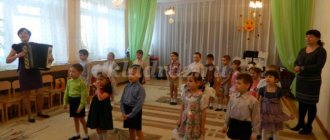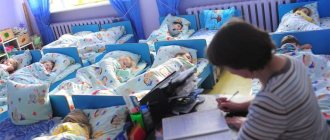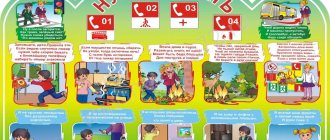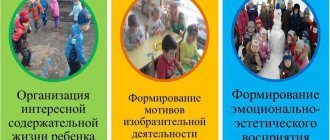The topic “Toys” must be used during speech therapy classes with preschoolers aged 2-7 years. Of course, the best pictures for children in kindergarten are Toys, which are specially selected for educational activities.
In the lexical material on this topic, several important “steps” can be identified, elements that must be mastered by preschoolers:
- The very generalizing concept of “toys”.
- Various names of items used for different types of games (story-based, action, etc.).
- General features and properties of toys, as well as their differences from other items.
- Ways to use certain toys.
- Features of their device.
- An idea of the material from which game items are made.
Here is a minimum list of words on the topic of toys for children that should be introduced into the active vocabulary of preschool children:
- Names of toys and their parts (nouns):
bear, bunny, dog, doll, car, ball, top, construction set, matryoshka, pyramid, head, torso, arm, leg, muzzle, paw, tail.
- Characteristics of items for games (adjectives):
* it is useful to teach them with children in pairs, comparing the properties of different toys.
Big - small, round - square, soft - hard, smooth - rough, fur - plastic, iron - wood, new - old.
- Various actions that can be performed with these objects (verbs):
Roll, carry, build, swing, dress, bathe, feed, wear, buy, lose, find, sew, play, collect.
Drawn pictures
For the formation of a passive vocabulary, pictures for children depicting various toys are of great importance. It is very good if they are presented in a wide variety, this allows you to offer the child many different speech exercises and activities.
For speech therapy games, it is much more convenient to use cards rather than real objects. Sorting and describing images not only contributes to children’s speech development, but also improves them:
- visual-figurative thinking;
- RAM;
- attention.
Of course, it is very difficult to draw such pictures yourself; it is better to find ready-made ones selected by professional speech therapists.
Coloring pages
To conduct classes on the topic “Toys” it is also very useful to use thematic coloring books. They help the child not only learn and remember all kinds of names of objects for games, but also practice using a large number of descriptive adjectives (in descriptions of various colors and materials). A correctly selected coloring book is a real helper for speech therapists and parents!
Middle group. Junior preschool age. Children 4 - 5 years old
Layout “Magic Winter” for children 4–5 years old
The long-awaited winter has arrived. Snowy with frosts and blizzards on one side, crystal and magical on the other. According to the tradition of our group, each new topic is a new interesting layout . Our children are 4-5 years and are excellent assistants in any work, especially creative work. For…
Master class on making a model “Autumn in our forest” for children 3–4 years old
Master class on making a model “Autumn in our forest”
for
children 3-4 years old Novikova G.F. I present to your attention the didactic manual “Autumn in our forest”
Love, understanding and care - this is what living nature expects from every person. It is advisable to start these feelings...
Games
With “Toys” pictures you can conduct many simple and effective speech therapy activities aimed at developing the speech of preschool children. Here are some examples of such games:
Name the pictures
The development of children's speech is facilitated by naming the various toys depicted on the cards. It is important to choose the most realistic drawings, this helps the child quickly recognize this or that object. Such pictures of toys for children must certainly be bright and attractive in appearance.
What's missing here?
The popular logic game “Odd Four” can also be used in speech therapy classes. During it, children are offered four images, three of which can be called in one word (“toys”), and one cannot; this card is selected from other categories (vegetables, plants, animals, transport, etc.). This game helps to enrich and activate passive vocabulary, and also perfectly trains the attention and thinking of preschoolers.
Which? Which? Which?
Show your child one picture at a time from the set of “Toys” cards and ask him to list the properties of the object depicted on it. For example: a doll - new, elegant, plastic, curly, blue-eyed, big, new, etc. If you have pictures from the Toys for Children series on a transparent background, then it is better to use them in this game.
Call me kindly
This game is great for developing the skill of using diminutive suffixes on nouns. An adult shows children 4 years and older toys (in pictures or real ones) and asks them to name them affectionately. Examples:
- doll - doll; - ball - ball; - bear - bear; - elephant - elephant; - hare - bunny; - car - machine; - jump rope - jump rope.
For children of senior preschool age 6-7 years old, you can conduct a complicated lesson: ask them to remember the names of toys that are used only in an “affectionate” form. (top, pyramid) or do not have it at all (spinning top, hoop, train, clown, etc.).
One-many
Teach your child not only to name toys one by one, but also to find one or another of them in a group of similar/identical images. Example:
ball - ball doll - dolls cube - cubes ball - balls.
Detectives
Another simple and exciting game that will help your child quickly learn the names of a large number of toys. As visual material for it you can use:
- Pictures;
- real objects for games;
- video materials.
First you need to show four different pictures with images of toys, and then hide (close) one of the cards. The baby must remember and name what is missing.
Guess what color
Invite your child to name the color of the toy you show him. You need to start with basic colors, then you can add more complex options, with shades (bright red, scarlet, dark green, light pink). During this game you can also reinforce the concepts
- bright; – multi-colored; - transparent; – multi-color.
Whose toy is this?
This exercise allows you to teach a preschool child how to coordinate nouns (names of toys) with personal pronouns. You show your child a picture and ask: “Whose is this?” Possible answers:
my (dog, spinning top, pyramid) my (ball, elephant, bunny, clown) my (lotto, dominoes) my (cubes, balls)
Who's doing what?
This game allows you to train the skill of agreeing a noun with a verb. Show your child pictures of toys (singular and plural, pairs) one at a time and ask the question: “What is this? What is he doing? Possible answers:
the doll is sleeping - the dolls are sleeping the parsley is sitting - the parsleys are sitting the bunny fell from the shelf - the bunnies fell from the shelf the top is spinning - the tops are spinning the ball rolled away - the balls rolled away the car broke down - the cars broke down the bear is sleeping - the bears are sleeping
The large picture “Toys for Children” can be used for a similar activity with several kids at once, in a group or subgroup.
What toy?
This fun game helps children learn the rules of noun-adjective agreement quickly and easily. Ask your child to come up with as many characteristics as possible for the toy whose image is in your hands. It is best to play this game among several children or in an adult-child pair. Try to avoid repeating adjectives; it is important to name as many different words as possible.
Example:
The horse is wooden, new, beloved, comfortable, hard, smooth, brown. Elephant - purple, soft, big, sad, big-eared.
Shop
The usual game of “shopping” can be slightly modified and effectively used to develop the speech of children in the senior and preparatory groups of kindergarten. Invite the children to choose a card from the “Toys” set, i.e., “make a purchase.” Then the boy or girl goes to the window and chooses a “purchase”. The child must accompany his actions with a correctly constructed complete sentence, in which he must name the selected object and several of its characteristics (color, material, size and other features). This exercise helps enrich children's active vocabulary and develop their imagination.
Example:
1. I want to buy a big yellow ball. 2. I want to buy a bright red cube. 3. I want to buy an elegant little doll. 4. I want to buy a set of wooden blocks in a box.
The picture Toys for Children on a transparent background is very suitable for this game, although ordinary cardboard cards can also be used.
Properties of Visual Aids
Depending on the didactic objectives, visual material may have the following properties:
Naturalness. This is real visual material such as animals and plants. With their help, children get acquainted with flora and fauna.
Experimentation. Conducting experiments, such as melting ice, helps children observe processes that also occur in nature.
Dynamic picture. These can be just photographs or images, or they can be films and filmstrips. Their task is to introduce children to new phenomena or facts, mapping them to native speakers.
Volume. Three-dimensional layouts are created that allow you to get an idea of the subject as a three-dimensional object, which expands the capabilities of a conventional image.
Sound. The teacher plays various sound files. For example, children may hear birds singing, running water, or other natural sounds.
Symbolism. Using a variety of diagrams and maps, you can help children use their abstract thinking to explore real-world objects.
Mixedness. This may be a film containing sound. This allows you to most fully reproduce reality using the visual aid method.
Before choosing the desired visual element, you need to think about what its didactic capabilities are.











